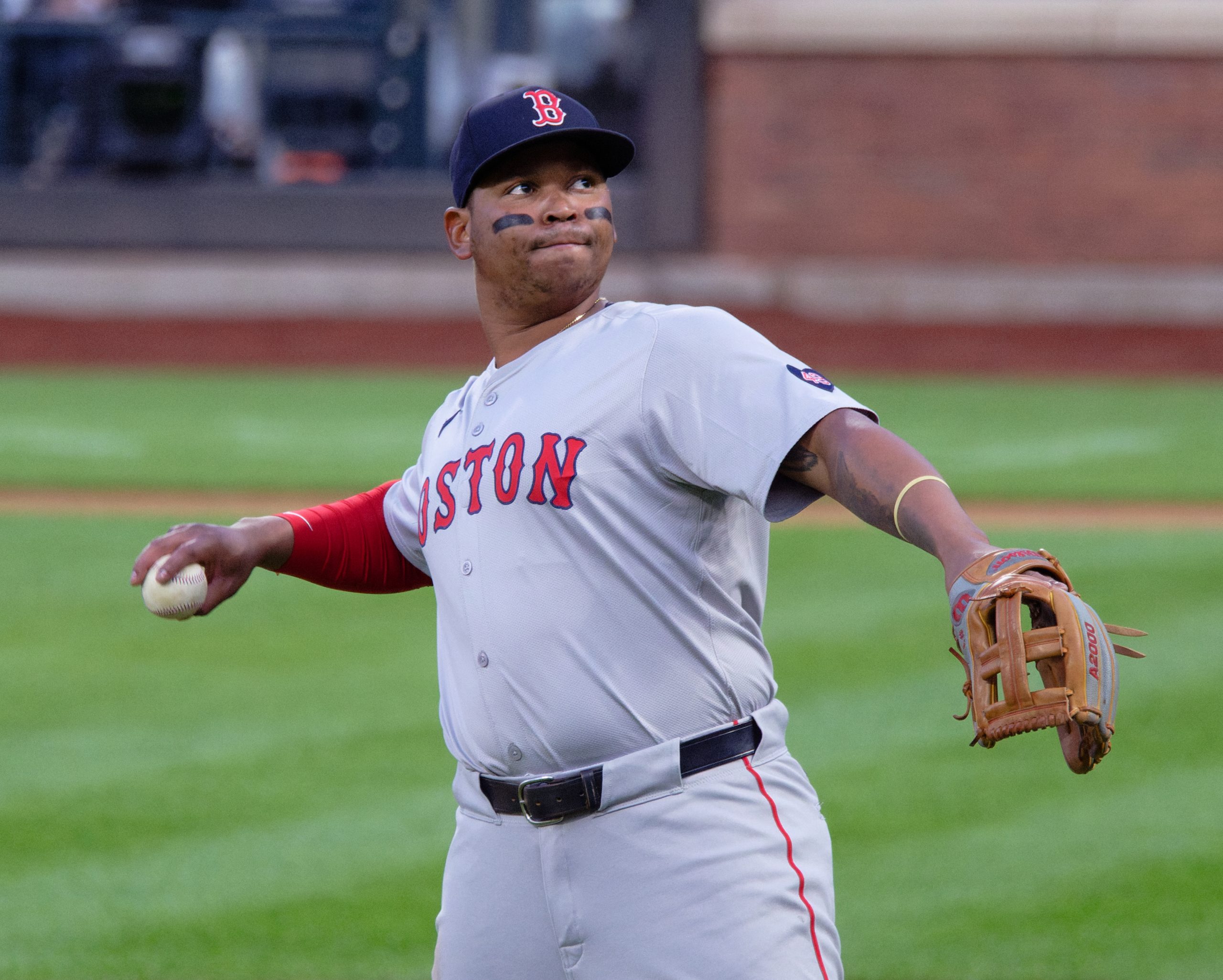Sports
Early MLB takeaways
Open Extended Reactions One month into the Major League Baseball season, the favorites are playing as expected (for the most part), the stars are off to great starts (more or less) and the game looks as it should (except for the two minor league parks). April offers a window into the next five months, though […]

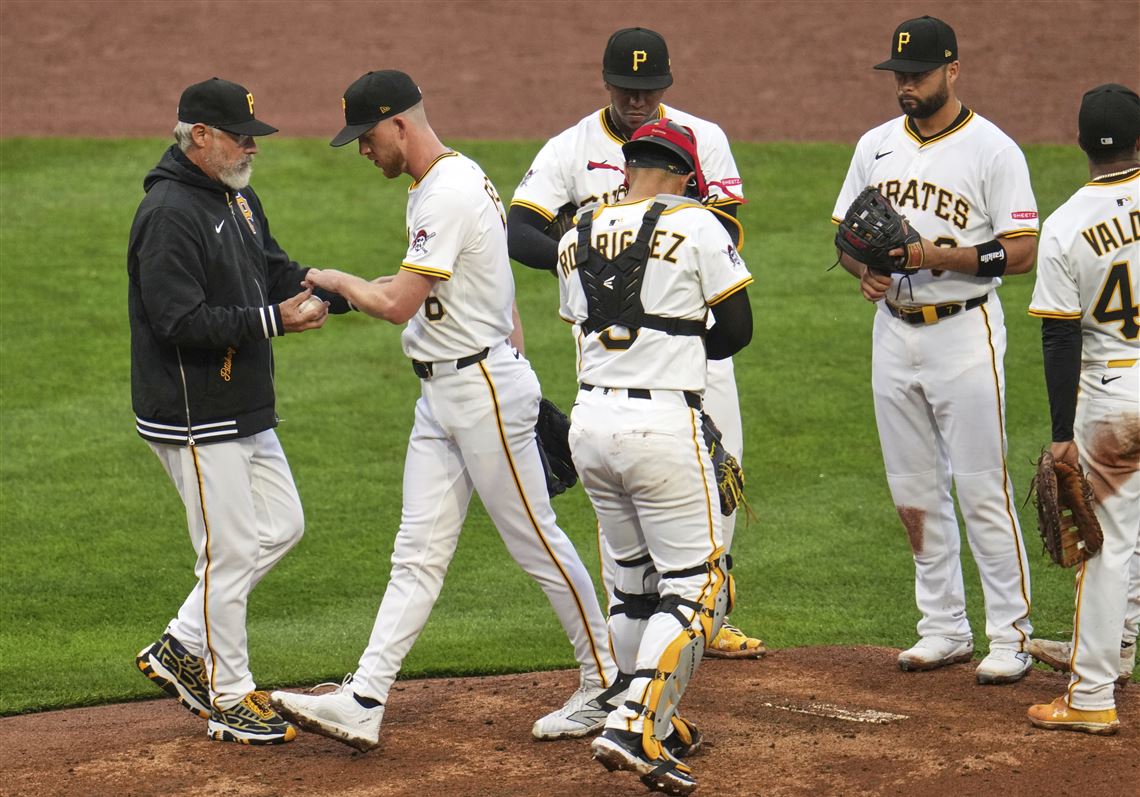
One month into the Major League Baseball season, the favorites are playing as expected (for the most part), the stars are off to great starts (more or less) and the game looks as it should (except for the two minor league parks). April offers a window into the next five months, though it’s still slightly opaque — a tease for what’s ahead.
Will there be another historic Aaron Judge season? A team breaking the record for futility just one year after a single-season record for losses was established? A new standard for on-field larceny? All of that and so much more are possible, according to a wide swath of players, coaches, executives, evaluators and analysts ESPN surveyed to understand what in April was real and what was more early-season mirage.
We’ll begin with one thing that is clear enough to say definitively. And while it might not mean anything come October, for May, June, July, August and September, it’s bound to prove true.
The National League is vastly superior to the American League
This disparity was anticipated, yes, but the degree to which the Senior Circuit dwarfs the Junior Circuit in almost every way — from record to run differential to preeminence of the best teams — only reinforces the chasm between the leagues.
Currently, the NL is 224-218 with a plus-69 run differential. And that’s despite the 4-25 Colorado Rockies and their -78 run differential. The combined OPS of NL hitters is 25 points higher than that of AL hitters. They walk more and strike out less, score way more and steal copious bases comparatively and hit more home runs. In interleague games, NL pitchers have an ERA that is more than a third of a run lower than that of their AL counterparts.
There is an argument to be made that seven NL teams are better than the AL’s best team (either the New York Yankees or Detroit Tigers, who have separated themselves by the end of April), and that doesn’t even include the Cincinnati Reds, who have a five-game winning streak and the fourth-best run differential in MLB (aided by a 24-2 win against Baltimore). The NL’s magnificent seven include:
![]()
Los Angeles Dodgers: The overwhelming World Series favorites have been just all right since an 8-0 start, with injuries hammering their starting rotation and offensive struggles by third baseman Max Muncy, outfielder Michael Conforto, utility man Kiké Hernández and even shortstop Mookie Betts. And yet the Dodgers still terrify opponents because of games like Sunday, when starter Tyler Glasnow exited because of a shoulder injury and was replaced by Ben Casparius, whose fastball sat at 97 mph, topped out at 99 and complemented a slider and curveball averaging 3,000-plus RPMs of spin. The Dodgers are great because of their stars, but they’re even more dangerous because their replacements also have elite ceilings.
![]()
San Diego Padres: For a team that entered 2025 with rotation questions, the Padres have managed to post seven shutouts, the most ever for a team through the end of April. Much of it is owed to their bullpen, which owns an MLB-best 1.66 ERA and has stranded 87.8% of runners, blowing away the league average of 71%. Powered by their nasty bullpen, starters Michael King and Nick Pivetta, and Fernando Tatis Jr. going full superstar mode, the Padres have managed most of April without star center fielder Jackson Merrill and second baseman Jake Cronenworth with aplomb. Once the Padres get healthy, look out.
![]()
New York Mets: They sport the best record in MLB — and have gotten to the top of the standings despite slow starts from Mark Vientos and Brandon Nimmo, with Juan Soto still seeking his power stroke. New York’s pitching has been nothing short of brilliant, with a rotation leading MLB in ERA by nearly three-quarters of a run at 2.27. And that’s without Sean Manaea and Frankie Montas, two free agent signings who have spent the first month on the injured list. It doesn’t hurt that Pete Alonso was the best hitter in the league in April, and Francisco Lindor is doing Francisco Lindor things, too. There might not be a more electric place to watch a ballgame these days than Citi Field, where the Mets are 13-1 this season.
![]()
Chicago Cubs: The Cubs have been baseball’s best offense by a significant margin so far and achieved the exceedingly rare 40/40 month: 42 home runs and 44 stolen bases in April. Chicago’s balance isn’t just power-speed, either; it’s up and down the lineup, from Kyle Tucker starting his walk year with a flurry to Pete Crow-Armstrong‘s breakout looking real to Carson Kelly hitting better than anyone in the sport in limited playing time. The Cubs’ pitching is problematic, though, and losing Justin Steele to reconstructive elbow surgery did them no favors. But with an offense on a 977-run pace and the easiest schedule in MLB for the remainder of the season, summer and fall in Wrigley could be a lot of fun.
![]()
San Francisco Giants: The season’s biggest surprise so far, the Giants look like the Padres Lite with excellent bullpen performances elevating steadiness across all other facets of the game. Randy Rodriguez has been a revelation in a relief corps that has also seen a bounce-back from Camilo Doval, consistent excellence from Tyler Rogers and the high-octane stuff of Hayden Birdsong playing up out of the pen. The offense has been more of a mixed bag. Willy Adames has struggled at the plate, but Jung Hoo Lee is looking like a potential star and Mike Yastrzemski ihad his best start in years. San Francisco’s hitters have thrived in big spots, highlighted by Wilmer Flores ranking third in the majors in RBIs thanks to a .387/.457/.677 line with runners in scoring position.
30 years of Coors Field horror stories For three decades, baseball at altitude has bruised ERAs and egos. Here’s what it’s really like taking MLB’s scariest mound. Story »
For three decades, baseball at altitude has bruised ERAs and egos. Here’s what it’s really like taking MLB’s scariest mound. Story »
![]()
Philadelphia Phillies: Let’s start with the good. On paper, Philadelphia remains one of the toughest teams in the NL. Zack Wheeler is the most consistent ace in baseball, Jesus Luzardo is pitching like the best version of himself, and coupled with Cristopher Sanchez‘s continued ascent, the starting pitchers all combine to make the Phillies a dangerous squad come October. Can they get there, though? The bullpen is a real issue, with the second-worst ERA in baseball (5.25) and only Jose Alvarado exceeding expectations. The bottom third of the Phillies’ lineup also needs to produce more, and the lack of home runs (24, which ranks 23rd in MLB) will catch up to their offense if it persists.
![]()
Arizona Diamondbacks: At some point, the Diamondbacks’ pitching is bound to right itself. A rotation of Corbin Burnes, Zac Gallen, Merrill Kelly, Eduardo Rodriguez and Brandon Pfaadt should not have the 24th-ranked starter ERA in MLB. Thankfully for the Snakes, the offense has been elite. Corbin Carroll has turned in an MVP-caliber April, Pavin Smith might be the best platoon player in MLB, Josh Naylor is bordering elite with his swing decisions, and Eugenio Suarez leads the big leagues in home runs. With Ketel Marte back soon and Jordan Lawlar destroying Triple-A, the Diamondbacks’ offensive excellence could get even better. And as long as the pitching stabilizes, Arizona will be a team nobody wants to face now or in October.
The stolen base is back and better than ever, but offense is still meh
When MLB introduced new rules in 2023, the implementation of larger bases and limiting of pickoffs weren’t talked about as much as adding the pitch clock and banning the shift. But both have had a demonstrable effect on the game. Perhaps not quite as much as the pitch clock — nine-inning games are averaging 2 hours, 37 minutes, almost dead even with last year’s 2:36 — but the changes that have brought back the stolen base have been far more significant than those the league hoped would help juice batting average.
Last year, MLB players stole 3,617 bases, the highest number in more than a century. This April’s stolen-base total already exceeds last year’s at this time (714 to 672), and runners aren’t going to stop stealing until catchers show they can more consistently throw them out.
With a success rate of 79.5% on steals of second — and 74.8% on attempts to swipe third — runners are emboldened. Anything in excess of 75% encourages teams to keep running, and with seven teams already pilfering more than 30 bases, they are gladly obliging, turning singles and walks into “doubles” regularly.
And it’s not only the fastest players in baseball who are thriving. Everyone is running. Bryce Harper, nobody’s idea of a stolen-base machine, has six in 29 games after swiping seven last season in 145 games. Manny Machado hasn’t stolen more than a dozen bases since 2018; he’s already halfway there.
On the other hand, an offensive regression last year alarmed executives who were hopeful the runs-per-game jump in 2023 meant offense would continue to blossom under baseball’s new rules. It has not. The numbers from the past four seasons through the end of April:
YearBAOBPSLG2022.231.307.3692023.247.321.4052024.240.314.3852025.242.316.392Walks are up three-tenths of a percentage point and strikeouts are down by the same amount. Runs per game are flat (4.38 last year, 4.34 this year). The ball is being put in play at the highest April rate since 2017 … but defenses are turning more of them into outs than the previous two years of new-rule ball.The torpedo bat was more moment than game changerMLB torpedo bats: What you need to know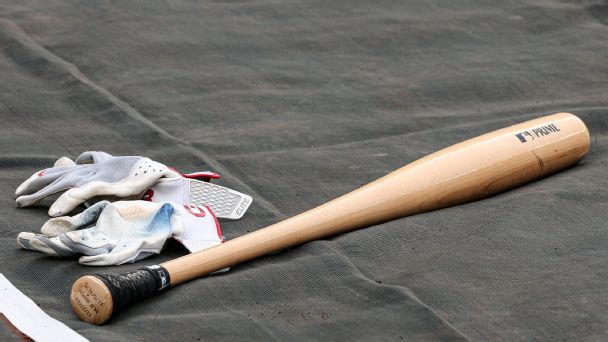 Torpedo-shaped bats have become MLB’s next big thing. Here’s what you need to know about the sport’s hottest trend.Passan: Inside the rise of torpedo bats »
Torpedo-shaped bats have become MLB’s next big thing. Here’s what you need to know about the sport’s hottest trend.Passan: Inside the rise of torpedo bats »
Olney: 48 hours of torpedo bat chaos »
FAQ: How they work, are they legal? »
Fantasy spin » | What players are saying »
Before the torpedo bat: History of experiments »
Oh, the halcyon days of opening weekend, when Yankees hitters unleashed the torpedo bat and looked as if they were about to revolutionize baseball.
With this novel-looking piece of equipment that forsook the standard shape of a bat and aimed to place more wood in the part of the bat that strikes balls most frequently, the hitters who embraced the torpedo looked like world beaters. The numbers from that opening series against Milwaukee were undeniably good.
Jazz Chisholm Jr.: .417/.500/1.167, 3 HRs, 6 RBIs in 14 PA
Austin Wells: .200/.333/.800, 2 HRs, 3 RBIs in 12 PA
Anthony Volpe: .167/.286/.667, 2 HRs, 4 RBIs in 14 PA
Cody Bellinger: .400/.357/.700, 1 HR, 6 RBIs in 14 PA
Since then, those players’ numbers have been:
Chisholm: .151/.279/.312, 4 HRs, 11 RBIs in 111 PA
Wells: .212/.258/.425, 3 HRs, 14 RBIs in 89 PA
Volpe: .242/.327/.434, 3 HRs, 15 RBIs in 113 PA
Bellinger: .184/.273/.322, 2 HRs, 10 RBIs in 99 PA
The torpedo bat, it turns out, doesn’t erase weaknesses of hitters. It’s also not fool’s gold. Cal Raleigh is using it with his left-handed swing, but not his right — and seven of his 10 homers have come from the left side, where he has an OPS nearly 300 points better than the right. Steven Kwan, who might as well be the anti-Raleigh, is also swinging a torpedo and is batting .333, seventh best in the big leagues.
Because of that opening-weekend blitz, though, the torpedoes will continue to be associated with the Yankees. And it’s worth noting that Judge has continued to swing a traditional bat and not only looks like the best hitter on the planet but by a significant margin. Judge leads MLB in each of the triple-slash categories (.412/.507/.728), ranks second in RBIs (29), second in runs (28) and third in home runs (nine). He is striking out in a career-low 20.6% of his plate appearances and continues to hit the ball harder and more consistently than anyone.
1:35
Why Jeff Passan considers Aaron Judge a little underappreciated
Jeff Passan breaks down Yankees outfielder Aaron Judge’s impressive play to Pat McAfee.
The Rockies are a real threat to the 2024 White Sox as the worst team ever
Where to begin? The Rockies are 4-25. They’re in the midst of their third six-plus-game losing streak. They have not won back-to-back games. They are dreadful on the road (1-14). They are abysmal at night (1-13). They cannot touch left-handed starters (0-9). They are striking out in 28.1% of their plate appearances, which would be a big league record. Their starters’ ERA is 6.73, which would be the worst mark in MLB history. They are 15½ games behind the Dodgers after one month.
Inside Paul Skenes’ rise to superstar status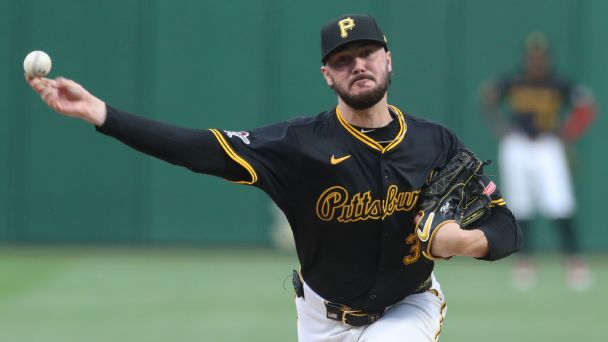 Amid the noise that comes with arriving as MLB’s next megastar, the Pirates’ ace is finding himself in the quiet. Jeff Passan »
Amid the noise that comes with arriving as MLB’s next megastar, the Pirates’ ace is finding himself in the quiet. Jeff Passan »
The Rockies are not bad — they are tragic. And what’s worst of all is it’s not for lack of trying by their owner, Dick Monfort, who has typically carried a middle-of-the-pack payroll. They are simply a baseball team that can neither score nor prevent runs, with an offense tied for last and a pitching staff that ranks 29th out of 30 teams.
The record of 120 losses held for more than 60 years before the White Sox went 41-121 last year. Their minus-78 run differential through 29 games was exactly the same as Colorado’s, but even the White Sox were 6-23.
Considering the Rockies still have to play 46 games against the Dodgers, Giants, Padres and Diamondbacks, Colorado’s road is far more treacherous than the White Sox’s through the AL Central. So watch out, White Sox. Your reign of futility might be only as a one-year placeholder for the burgeoning champions of misery.
1:14
Jeff Passan: The Rockies spend money, they just don’t spend it well
Jeff Passan tells “The Pat McAfee Show” that the Rockies are on pace to be the worst team in MLB history, surpassing the Chicago White Sox.
The pitching woes of the Orioles and Braves have dug mighty holes
All winter, Orioles fans waited in vain for the move to replace former ace Burnes in Baltimore’s rotation. And after projected Opening Day starter Grayson Rodriguez went down because of a shoulder injury and Zach Eflin hit the injured list because of a lat strain, it has become clearer than ever that the O’s lack the sort of starting pitching to stay competitive in the AL East. Kyle Gibson, their latest effort at replacing Rodriguez and Eflin, gave up four home runs to the Yankees in the first inning of his first start Tuesday. Now 11-18, the Orioles have given up the most runs in the AL and haven’t hit their way out of the pitching deficits they continue to face.
The money Baltimore did spend this winter also has not worked out well. Tyler O’Neill (three years, $49.5 million) has been a league-average player. Gary Sanchez (one year, $8.5 million) has been awful and is hurt. Charlie Morton (one year, $15 million) has the highest ERA in the AL. Andrew Kittredge (one year, $10 million) still hasn’t thrown a pitch. Only Tomoyuki Sugano (one year, $13 million) has been passable, and his lack of strikeouts does not portend good things, though he managed to find success despite it in Japan.
Like the Orioles, Atlanta is suffering from a paucity of pitching depth. The Braves have cycled through an MLB-high 22 pitchers this season, and the loss of Reynaldo Lopez to Tommy John surgery, Spencer Strider to a hamstring injury and Joe Jimenez to knee surgery have taken a weakness and made it worse. Things would be better if the Braves were hitting, but outside of Marcell Ozuna, Austin Riley and Matt Olson — who’s slugging under .400 — the juggernaut lineup of two years ago remains AWOL.
There is hope for Atlanta in the form of Ronald Acuna Jr.’s upcoming return from an ACL tear and Strider’s hamstring healing. And they’re starting to win. Since an 0-7 start, the Braves are 14-8; they’re currently 6½ games behind the Mets and only two shy of the Phillies. It’s still early, but the Braves could soon look more like the team that won the World Series three years ago.
Five pitchers who are 2025’s breakout aces
We’ve focused on the themes and teams that have shaped the first month so far. Now, we’ll turn our attention to the players who have caught our eye, for better … or worse.
Hunter Brown, RHP, Houston Astros: The quietest ace in baseball began his run of dominance early last season but is only now beginning to receive the recognition he warrants. With a fastball up to 99 mph, a vicious sinker, a swing-and-miss changeup and three more pitches, he has the arsenal to complement his moxie. He is the next great Astros pitcher.
Max Meyer, RHP, Miami Marlins: Meyer’s six-inning, 14-strikeout gem against Cincinnati illustrated what the No. 3 pick in the 2020 draft can be. His slider is one of the best in MLB and he throws it 50% of the time. Combine it with a fastball that sits at 95 mph and plays at the top of the zone and he’s primed to anchor the Marlins’ rotation with Eury Perez for years to come.
MLB Watchability Index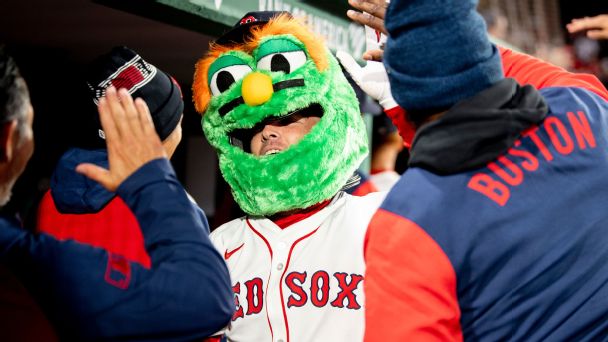 Star power, mammoth home runs and … cotton candy fries!? Here are baseball’s most exciting squads for 2025. David Schoenfield »
Star power, mammoth home runs and … cotton candy fries!? Here are baseball’s most exciting squads for 2025. David Schoenfield »
Shane Baz, RHP, Tampa Bay Rays: Baz sat out nearly two years after Tommy John surgery in 2022, and though he looked excellent in his return last year, there was even more in the tank. Between his 97 mph fastball and hard curveball, he has one of the best two-pitch combinations in baseball. With Shane McClanahan out, the Rays needed one of their young arms to step up, and Baz has done just that.
Matthew Liberatore, LHP, St. Louis Cardinals: Continuing the theme of post-hype prospects is the 25-year-old Liberatore, who came into camp as an underdog to win a rotation spot after spending most of last year in the bullpen. He has rewarded the Cardinals with the lowest walk rate in baseball (two in 31 innings) and complemented it with only one home run allowed. With a six-pitch mix, Liberatore has cemented himself as a fixture for a Cardinals team in need of a reimagination.
Nick Pivetta, RHP, San Diego Padres: The 32-year-old Pivetta has spent upward of a decade tantalizing evaluators with his stuff and always found himself done in by the home run ball. In 35⅓ innings this season, he has given up two homers, and three of his six outings ended after seven shutout innings. The best part of Pivetta’s game: He’s getting tremendous amounts of in-zone swing-and-miss, a testament to the quality of his stuff.
Five hitters who are 2025’s breakout bats
Corbin Carroll, OF, Arizona Diamondbacks: The 24-year-old Carroll excels at almost everything he tries, which made last year’s first-half swoon so uncharacteristic. His aggressiveness this season — Carroll’s out-of-zone and swing-and-miss percentages have rocketed up — belies an intelligent approach that’s happy to trade whiff for production. Thanks to his speed, Carroll always will be useful. But the Diamondbacks want more than that. And if he maintains anything close to his early-season line (.298/.365/.645), they’ll have a top-10 player in the game.
Pete Crow-Armstrong, CF, Chicago Cubs: The question with Crow-Armstrong was always about ceiling vs. floor. Because his glove is so good, he could carve out a plenty fine big league career as a defense-first center fielder. But Crow-Armstrong wanted to be a great player, not simply a top-flight defender. His improvements at the plate are clear not only because of the numbers but how he’s getting them. Namely, he’s making good contact on good pitches, going from an in-zone whiff percentage of 24.6% last year to this year’s 13.5%.
James Wood, OF, Washington Nationals: If Wood ever figures out how to consistently elevate the ball, he will be one of the best hitters in baseball. As is, even with an average launch angle of 3.2 degrees — the 11th lowest of 219 qualified hitters — he has managed to whack nine home runs. Five have gone to the opposite field. At 6-foot-7, Wood packs uncommon power, particularly when he goes the other way. He’s starting to get to it, an alarming prospect for pitchers who know that pounding the outside corner is simply an invitation for Wood to do what he does better than just about anyone.
Oneil Cruz, CF, Pittsburgh Pirates: It’s finally looking like the year that one of the most physically talented players in baseball evolves into one of the best. Since he debuted in 2021, the 6-foot-7 Cruz has hit the ball as hard as anyone not named Judge. This season, he is striking out less, walking significantly more, lashing home runs and stealing bases. And while his center-field defense leaves plenty to be desired, it’s a reasonable price to pay for such exceptional offensive production.
Jung Hoo Lee, CF, San Francisco Giants: Lee doesn’t hit the ball particularly hard, limiting his ultimate ceiling, so he’ll have to settle for simply being a damn good baseball player. He rarely strikes out. He plays a solid center field. He’s a natural on the basepaths. And at 26, in his first full season after a shoulder injury sustained crashing into an outfield wall last May ended his season, Lee can fulfill his destiny as the best South Korea-born player in MLB since Shin-Soo Choo.
Five players whose slow starts warrant panic
Tanner Bibee, RHP, Cleveland Guardians: His strikeouts are down, his walks way up and his home runs allowed alarming. Bibee, signed to a five-year, $48 million contract extension in spring training, added a new cutter this winter — and it’s not working. Neither, at this point, is his fastball, a slower slider and his changeup. In five starts, Bibee has generated only 39 swings and misses. For someone expected to spearhead Cleveland’s rotation, he has a lot of work to do.
The state of MLB ballparks Two MLB teams will be playing in minor league ballparks this season. Here’s what it says about the sport. Jeff Passan »
Two MLB teams will be playing in minor league ballparks this season. Here’s what it says about the sport. Jeff Passan »
Inside the transformation of Steinbrenner Field »
Raisel Iglesias, closer, Atlanta Braves: In 11 innings, Iglesias has given up more home runs (five) than he did in 69⅓ innings last year (four). He weathered a precipitous dip in strikeout rate last season, but his slider — always a strength — is catching too much of the strike zone and being ambushed.
Marcus Semien, 2B, Texas Rangers: Semien is a notoriously slow starter, but the lack of power and bat speed is disconcerting even for him. On top of that, he has yet to steal a base in 29 games, and though nobody would ever mistake him for Rickey Henderson, it was always the little things that made Semien such a beloved player. At 34, climbing out of an early-season hole will be that much trickier.
Anthony Santander, OF, Toronto Blue Jays: Spending the first month as a $92.5 million free agent below the Mendoza Line is tough. Doing so with a barrel rate that has cratered and only three home runs this year after hitting 44 is doubly so. Santander is not elevating the ball nearly as well as he did in 2024 — a problem Vladimir Guerrero Jr. had last year before his second-half resurgence. If the Blue Jays have any hope of contending in the AL East, they’ll need Santander to do the same.
Luis Robert Jr., CF, Chicago White Sox: The White Sox held onto Robert this winter figuring his value had reached its nadir and that they could rebuild it and move him at the trade deadline. Not only has he been a demonstrably worse hitter, his center-field defense also has plateaued. This is the ultimate change-of-scenery candidate, though with a club option for $20 million in 2026 and 2027, teams could treat Robert as more of a rental than long-term solution. With a turnaround, he could well earn it.
Sports
Day One of the 2025 OSAA State Track & Field Championships — TrackTown USA
“It’s crazy,” Weer said of the field. “I think four of us are from my district…it’s crazy to have so many fast people, especially in the 1A competition. I never imagined that we’d all run this fast.” Thursday was Weer’s first time running at Hayward Field — she’d watched state championship races there before, but […]
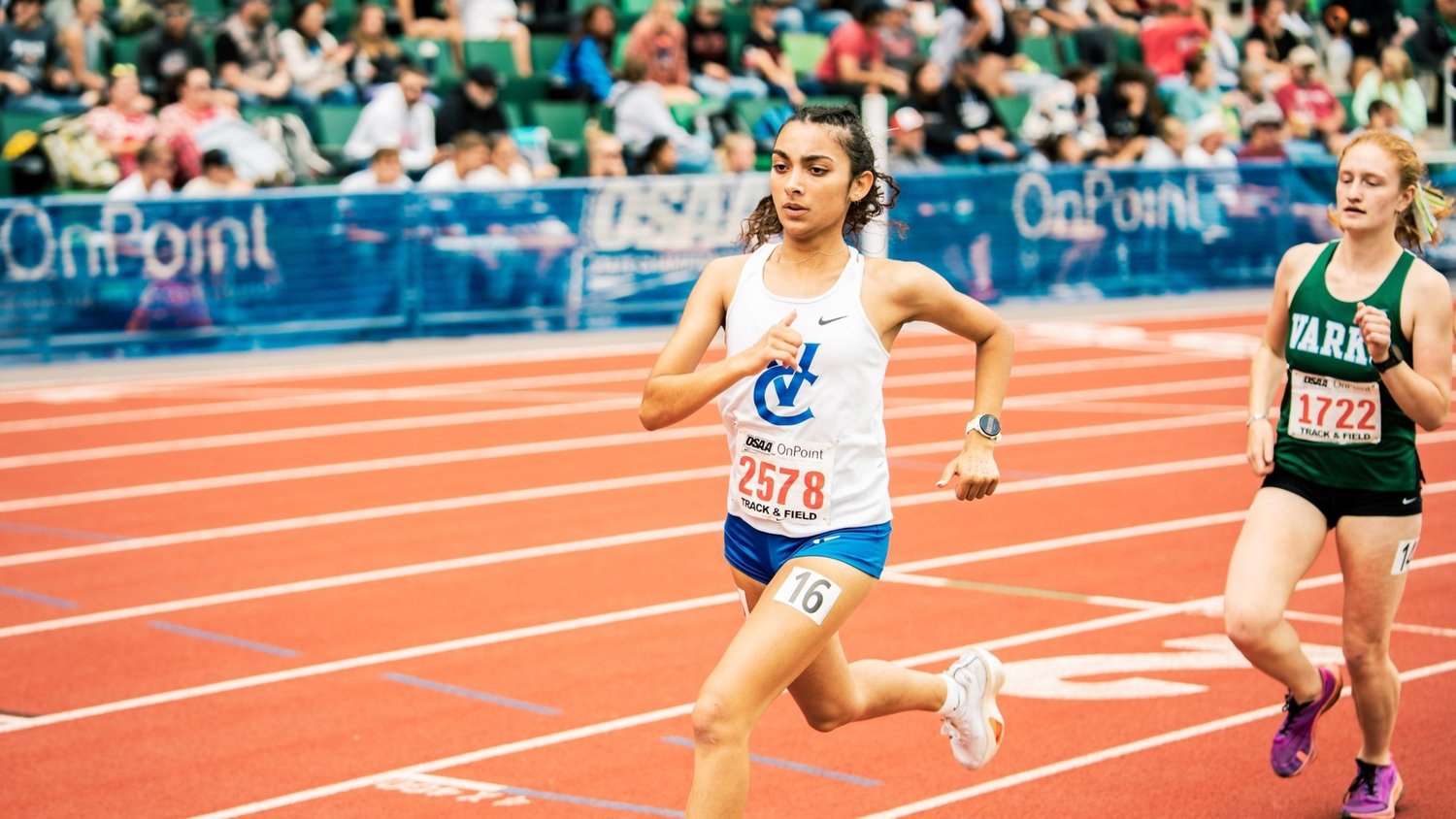
“It’s crazy,” Weer said of the field. “I think four of us are from my district…it’s crazy to have so many fast people, especially in the 1A competition. I never imagined that we’d all run this fast.”
Thursday was Weer’s first time running at Hayward Field — she’d watched state championship races there before, but got to take the track for the first time in her win. She tried not to watch herself on the looming video board, she said — she focused on the kick that “comes when she needs it to”.
She needed it in the final…and it came. She won by less than three seconds.
“Everything is so big,” Weer said of the stadium. “It’s amazing how this is one of the biggest tracks in the country, and so cool to be able to run on that. Not a lot of high school students get to do that.”
Weer’s teammate, boys’ 3000m winner Jett Leavitt, didn’t need a kick. He won his race by more than 51 seconds, in 8:30.37 — a new personal-best and OR #16 time. In second place, too, was his training partner, Jonah Lyman.
“I think it’s really cool,” Leavitt said. “It happened last year, too, but seeing him finish at the end not too far behind me is so cool. We train every day together. Seeing my friend and my teammate finish with me is really cool.”
3A girls’ 3000m winner Jaya Simmons’ win was her second-consecutive state title in the race; a 9:54.73 time secured the win in what could be the Valley Catholic High School senior’s final race in that uniform.
“There was definitely a lot of pain on the final lap,” Simmons said. “I really went out hard, but just knowing as a senior that this is my last 3000m here meant that I had to push through that last lap.”
Friday at Hayward Field welcomes the 4A, 5A and 6A competitors to the stadium. Competition begins with the 4A girls’ 3000m at 9:00 a.m. Pacific time.
Sports
MacLean Races To USTFCCCA All-American Accolades
Audrey MacLean earned a pair of All-American finishes. Story Links Audrey MacLean of the Middlebury women’s track and field team tallied a pair of United States Track & Field and Cross Country Coaches Association (USTFCCCA) All-American honors. The awards are based on the athlete’s performance at the NCAA Outdoor Track & Field […]
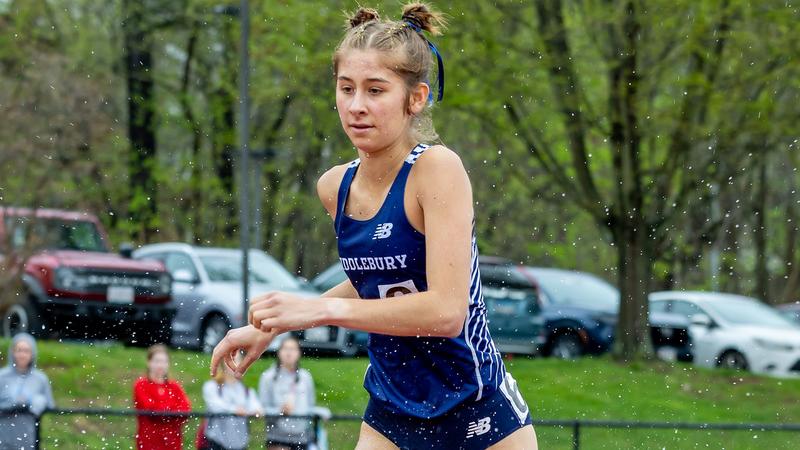
Audrey MacLean earned a pair of All-American finishes.
Audrey MacLean of the Middlebury women’s track and field team tallied a pair of United States Track & Field and Cross Country Coaches Association (USTFCCCA) All-American honors. The awards are based on the athlete’s performance at the NCAA Outdoor Track & Field Championships.
HONOREE HIGHLIGHTS
- MacLean (First Team)
- MacLean earns a pair of All-American outdoor laurels, giving her six accolades over her first two years. She is a two-time All-American on the cross country stage, garnered first-team laurels in the 5,000 meters during the indoor season, and is a three-time recipient outdoors.
- This marked MacLean’s fourth appearance at a national meet, competing at the NCAA Championships in cross country each of the last two years, while placing sixth in the 3,000-meter steeplechase a year ago.
- During the steeplechase preliminaries, the Panther crossed the line first with a clocking of 10:33.39.
- In the final on Friday, MacLean paced the pack throughout and held off a late charge by Hamilton’s Keira Rogan to earn runner-up honors with a time of 10:23.59.
- On Saturday in the 5,000, MacLean settled into the middle of the pack in the opening laps of the race, climbing 10 spots by the midway point.
- The sophomore maintained 10th place until the final 400, where she passed a pair of competitors to finish in eighth place with a time of 16:42.81.
- This season, MacLean rewrote the record books for Middlebury with top clockings in the steeplechase (10:21.15) and the 5,000 (16:26.94).
Middlebury has 64 Outdoor All-American women’s honorees. Those who finish in the top-eight spots individually or in a relay earn first-team distinction, while individuals claiming ninth through 16th and relays earning ninth through 12th tally second-team laurels. The full list of honorees can be found here.
Sports
Is the Red Sox season already over? Plus, Dodgers trade for a new pitcher
Sports
Barrios Punches Ticket to NCAA Championship Final, Burnett Advances to Quarterfinals
Story Links COLLEGE STATION, Texas – University of Missouri track and field’s Valentina Barrios punched her ticket to the national final in women’s javelin while Alicia Burnett advanced to the quarterfinals in the 100m after running a school-record 11.13 on day two of the opening round of the NCAA Championships at E.B. Cushing Stadium on […]

COLLEGE STATION, Texas – University of Missouri track and field’s Valentina Barrios punched her ticket to the national final in women’s javelin while Alicia Burnett advanced to the quarterfinals in the 100m after running a school-record 11.13 on day two of the opening round of the NCAA Championships at E.B. Cushing Stadium on Thursday.
Barrios, a junior, followed up her Southeastern Conference Championship performance with a fifth-place result of 56.71m (186-0). She joins Callan Saldutto in Eugene, Oregon, the site of the final rounds of the NCAA Championships, as the two will compete for the school’s first national championship in javelin on either the women’s or men’s side.
After setting the school record in the 100m on April 18, Burnett topped it by a tenth of a second to finish in ninth and earn a spot in the quarterfinals of the event. She competes next on Saturday at 6:35 p.m.
Day two again started with the hammer throw, where Reagan Kimrey led the Tigers in 30th place with 57.17m (187-6) to conclude her freshman season. Petra Gombas closely followed with a throw of 55.03m (180-6), claiming 38th.
Senior Kaesha George capped off her campaign in 18th in women’s javelin after throwing 47.58m (156-1). Led by Barrios, the squad was rounded out by Val Galligan in 29th place (45.77m/150-2) and Morgan Cannon in 45th (36.29m/119-0).
In the track events, Burnett took 34th in the 200m in 23.63, while freshman Monica Wanjiku capped off her stellar freshman season with an 18th-place result in the 10,000m, finishing in 34:49.42.
UP NEXT
The Tigers continue postseason action at round one of the NCAA Outdoor Track & Field Championships on Friday, May 30, beginning with the men’s discus at 1 p.m., where Skylar Coffey and Tarique George will represent Missouri.
FOLLOW THE TIGERS
For all the latest on Mizzou Cross Country and Track & Field, stay tuned to MUTigers.com and follow the teams on Facebook, Instagram and X (MizzouTFXC).
Sports
Trump Administration Goes After Fresno-Area Track and Field Competition Over Trans Athlete
Heading into this weekend’s State Track and Field Championships, the California Interscholastic Federation made a rule change to appease the Trump administration’s furor over a trans athlete being allowed to participate. This weekend is the California Interscholastic Federation’s high school State Track and Field Championships in Clovis, California, an event which, to be honest, we […]

Heading into this weekend’s State Track and Field Championships, the California Interscholastic Federation made a rule change to appease the Trump administration’s furor over a trans athlete being allowed to participate.
This weekend is the California Interscholastic Federation’s high school State Track and Field Championships in Clovis, California, an event which, to be honest, we do not normally cover. But the stakes at this competition are incredibly high this year, for reasons that have very little to do with track and field.
The New York Times reports that the Trump administration is ginning up outrage that a trans female athlete is competing, so much outrage that they’re planning a full-on Department of Justice investigation into the matter. The administration is also threatening to withhold “large scale” federal funding from the entire state of California over the matter.
Visalia’s KMPH reports that Clovis Mayor Pro Tem Diane Pearce jumped into the dispute, hoping to sway Gavin Newson to step in and ban the high school student from competing. “Just this morning, President Trump posted on social media about our state finals saying that what is about to happen here in Clovis is ‘not fair’ and reminded everyone Gov. Newsom said that too,” Pearce said in a Tuesday statement. “A biological male will be competing against our girls and he is favored to win the state title in at least one event.”
“Is favored to win?” Are oddsmakers really setting favorites on high school track and field competitions in the Fresno area, or did Diane Pearce just make that up out of whole cloth?
Either way, the response has been fairly swift. Sacramento’s KCRA reports that the California Interscholastic Federation has crafted a new compromise rule that would allow the trans athlete to compete, but would not allow any “biological female” student-athletes to be eliminated from competition by that trans athlete.
“Under this pilot entry process, any biological female student-athlete who would have earned the next qualifying mark for one of their Section’s automatic qualifying entries in the CIF State meet, and did not achieve the CIF State at-large mark in the finals at their Section meet, was extended an opportunity to participate in the 2025 CIF State Track and Field Championships,” the federation says in their new policy. “The CIF believes this pilot entry process achieves the participation opportunities we seek to afford our student-athletes.”
Governor Gavin Newsom, known recently for cozying up to right-wing anti-trans sentiment, seems pleased with the compromise move.
“CIF’s proposed pilot is a reasonable, respectful way to navigate a complex issue without compromising competitive fairness,” Newsom spokesperson Izzy Gardon said in a statement. To Politico. “The Governor is encouraged by this thoughtful approach.”
But will this work to appease Trump and his administration? I’m guessing it won’t! While conservatives argue this is about protecting women athletes from discrimination, the political game here seems more about using the trans community as a wedge political issue, and punishing states that acknowledge that trans people exist. And if that’s the goal, reasonable compromises might not be possible, or even desired.
Related: Judge Won’t Block San Jose State From Conference Volleyball Tournament Over Alleged Transgender Player [SFist]
Image: A group of young women on the starting line, focused and ready to sprint at full speed. Training starts for their next track and field competition. (Getty Images)
Sports
Prestina Ochonogor punches ticket to NCAA National Championships
Story Links BRYAN-COLLEGE STATION, Texas – Prestina Ochonogor became the second Texan in as many days to qualify for the NCAA National Championships at the NCAA West Preliminary Rounds at E.B. Cushing Stadium on Thursday. Along with Ochonogor punching a ticket to Eugene, Victoria Cameron earned a berth in […]
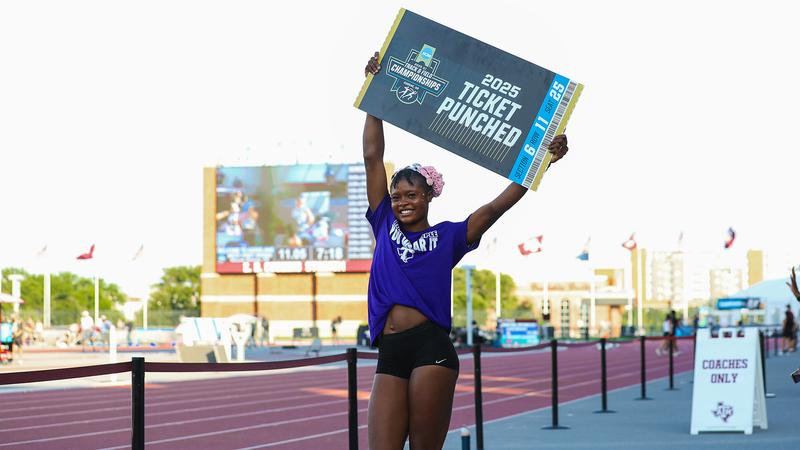
BRYAN-COLLEGE STATION, Texas – Prestina Ochonogor became the second Texan in as many days to qualify for the NCAA National Championships at the NCAA West Preliminary Rounds at E.B. Cushing Stadium on Thursday.
Along with Ochonogor punching a ticket to Eugene, Victoria Cameron earned a berth in Saturday’s quarterfinals in both the 100 and 200. Cameron will be in the 24 women field in each event in hopes of posting a top 12 finish to earn a spot in Eugene in each event.
“I’m so proud of this young lady right here,” said head coach Bobby Carter” “Again, I’ve told my athletes, it’s all about surviving and advancing. Today she did just that! There will be much more to come.”
WAC Female Freshman of the Year, Prestina Ochonogor, became the second Texan to punch her ticket to Eugene. Ochonogor increased her leap on each of her three jumps. She started with a 7.33-meter jump on her first attempt. Her second attempt just posted a 7.47-meter mark which would have been enough to qualify, but she wasn’t done yet. The Benin, Nigeria, native, then posted a 6.66-meter jump just a centimeter shy of her school record. The leap qualified Ochonogor for nationals with the second-best leap in the NCAA West Preliminary Rounds.
“I want to thank God and I am very grateful from the beginning to the end,” said Ochonogor after punching her ticket. “I want to thank my family and coaches. Go Texans, I love you! See you in Oregon!”
Ochonogor is not new to the big stage. This past summer at 17 years old, she represented Nigeria at the 2024 Paris Olympics in the long jump. She placed 12th in the stacked field and was one of the youngest track athletes at the Games. The freshman will be making her second appearance at an 2025 NCAA National Championships after earning a First Team All-American honor earlier this year. She finished eighth in the long jump at the indoor championships.
The 2025 WAC Female Outdoor Athlete of the Year, Victoria Cameron earned a spot in both the 100-meter and 200-meter quarterfinals on Saturday with her Thursday night performances. First, the sophomore won her heat in the 100 in 11.07 seconds and qualified for Saturday with the sixth best performance. In her first race of the day, the Stephenville native narrowly broke her school record again, coming within .02 seconds. The Texan is the only athlete from a non-Power Four Conference among the top 18 qualifiers in the 100.
Less than two hours later, Cameron punched her ticket for Saturday in the 200 meters. The sophomore finished second in her heat crossing in 23.19 seconds. She posted the 17th fastest time in the 48 women field. She will punch a ticket to the NCAA Championships in Track Town USA by being among the top 12 runners in the field of 24 in each event set to run on Saturday.
A pair of Texan women also competed in the 200. Lauren Roy finished 32nd in the field in 23.56 seconds. Amandine Estival crossed in 23.79 seconds to earn 38th overall.
Friday, the Texans will be in hopes of punching a pair of tickets to Eugene in the men’s triple jump. In the final day of the men’s NCAA West Preliminary Rounds, both Sir Jonathan Sims and Gabriele Tosti will be competing in the triple jump. The duo will be competing in the fourth flight, estimated to start around 3:45 p.m. Tosti enters as the third ranked jumper in the nation and Sims boasts the ninth best jump in the West.
On Saturday, Cameron will be running in three events all with the chances to punch herself a ticket to Oregon. She will start in the 4×100 relay scheduled to run at 5 p.m. with her teammates, Hanna Dudley, Amandine Estival and Lauren Roy. She will then run in the third heat of the 100 meters slated to start at 6:35 p.m. Her final race of the day will be in the 200 racing out of the first heat at 7:50 p.m. Sofia DeGroot will make her NCAA West debut in the triple jump at 2:30 p.m.
With just two days left at the NCAA West Preliminary Rounds, the top 12 in each event on each of the final two days will earn themselves a trip to Eugene. The Purple and White have four individuals still looking to punch their tickets to Eugene, Ore., as well as a four-women relay team. The NCAA National Championships will be held at Hayward Field from June 11-14.
-

 College Sports1 week ago
College Sports1 week agoPortal Update – Basketball and Gymnastics Take Hits
-

 Rec Sports2 weeks ago
Rec Sports2 weeks agoThe Program, a New Basketball Training Facility, Opening in Greenpoint This September
-
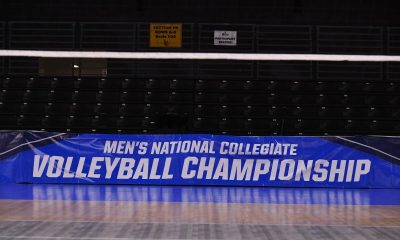
 Sports3 weeks ago
Sports3 weeks ago2025 NCAA men’s volleyball championship: Bracket, schedule, scores
-
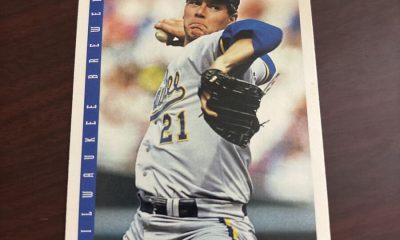
 Sports3 weeks ago
Sports3 weeks agoMajor League Baseball results
-
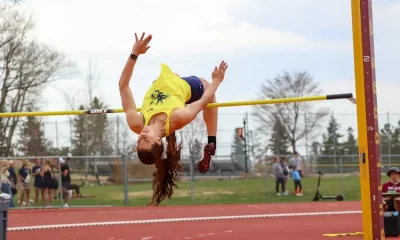
 Sports3 weeks ago
Sports3 weeks agoGreenwaldt and Sallee Take NSIC Titles in Day Two
-
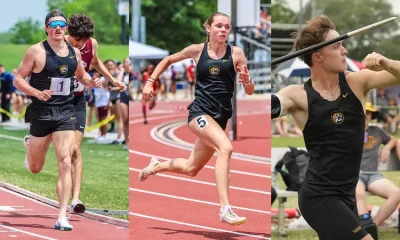
 Sports3 weeks ago
Sports3 weeks agoBarnes, Lippert and Smeal Set School Records at APU Franson Meet
-

 Youtube3 weeks ago
Youtube3 weeks agoAnthony Edwards’ Top 10 Plays of the 2023-24 NBA Regular Season! #BESTofNBA
-

 Sports3 weeks ago
Sports3 weeks agoTaylor releases 2025 volleyball, football schedules
-

 NIL3 weeks ago
NIL3 weeks ago2025 NCAA Softball Tournament bracket, schedule revealed
-
Sports3 weeks ago
Beach volleyball pairs championship: Day one — The


